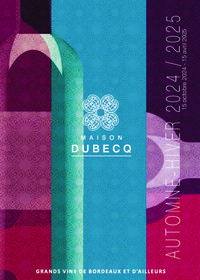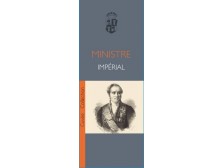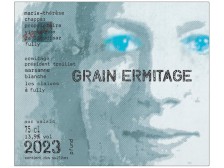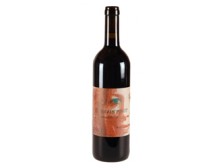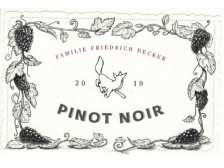Catalog
-
With a priceless ampelographic collection built up by his father Antoine in the 1960s, Jean-Charles Abbatucci is the guardian of the endemic grape varieties and wine-making traditions of Corsica. This variety of grapes (with melodious names: Carcajolo Bianco, Paga Debbiti, Rossola Brandinca...) coupled with a sumptuous terroir of 14 ha full hillside south of Ajaccio and a demanding viticulture (biodynamic since 2000) explains the special place of Domaine Abbatucci within the Corsican producers. It is with the white wines, certainly among the most beautiful of the Mediterranean basin, that this domain has built up an unequalled reputation.
The first cuvée Faustine, 100% vermentino, is a direct entry into the Abbatucci universe: floral (aniseed) and delicately apricot on the nose, supple (without any heaviness) and elegant on the palate, with a fine bitterness on the finish.
Rated three stars in the Revue du Vin de France's annual guide.
The 2023 vintage in the press:
La Revue du Vin de France (Guide 2025): 92/100 “Svelte and uncluttered, the white is dynamic and mineral.”
More- To keep or to drink:
- Ready to drink
- Apogée:
- 2023-2028
-
With a priceless ampelographic collection built up by his father Antoine in the 1960s, Jean-Charles Abbatucci is the guardian of the endemic grape varieties and wine-making traditions of Corsica. This variety of grapes (with melodious names: Carcajolo Bianco, Paga Debbiti, Rossola Brandinca...) coupled with a sumptuous terroir of 14 ha full hillside south of Ajaccio and a demanding viticulture (biodynamic since 2000) explains the special place of Domaine Abbatucci within the Corsican producers. It is with the white wines, certainly among the most beautiful of the Mediterranean basin, that this domain has built up an unequalled reputation.
The first cuvée Faustine, 100% vermentino, is a direct entry into the Abbatucci universe: floral (aniseed) and delicately apricot on the nose, supple (without any heaviness) and elegant on the palate, with a fine bitterness on the finish.
Rated three stars in the Revue du Vin de France's annual guide.
Rated 92/100 by La Revue du Vin de France "This cuvée was made in 1998 when my daughter Faustine was born. It is a 100% vermentino planted on granite arena. A brilliantly coloured wine with lots of freshness and minerality. Ideal with fish or white meats." (January 2024)
More- To keep or to drink:
- Ready to drink
- Apogée:
- 2023-2028
-
With a priceless ampelographic collection built up by his father Antoine in the 1960s, Jean-Charles Abbatucci is the guardian of the endemic grape varieties and wine-making traditions of Corsica. This variety of grapes (with melodious names: Carcajolo Bianco, Paga Debbiti, Rossola Brandinca...) coupled with a sumptuous terroir of 14 ha full hillside south of Ajaccio and a demanding viticulture (biodynamic since 2000) explains the special place of Domaine Abbatucci within the Corsican producers. It is with the white wines, certainly among the most beautiful of the Mediterranean basin, that this domain has built up an unequalled reputation.
The first cuvée Faustine, 100% vermentino, is a direct entry into the Abbatucci universe: floral (aniseed) and delicately apricot on the nose, supple (without any heaviness) and elegant on the palate, with a fine bitterness on the finish.
Rated three stars in the Revue du Vin de France's annual guide.
More- To keep or to drink:
- Ready to drink
- Apogée:
- 2024-2030
-
With a priceless ampelographic collection built up by his father Antoine in the 1960s, Jean-Charles Abbatucci is the guardian of the endemic grape varieties and wine-making traditions of Corsica. This variety of grapes (with melodious names: Carcajolo Bianco, Paga Debbiti, Rossola Brandinca...) coupled with a sumptuous terroir of 14 ha full hillside south of Ajaccio and a demanding viticulture (biodynamic since 2000) explains the special place of Domaine Abbatucci within the Corsican producers. It is with the white wines, certainly among the most beautiful of the Mediterranean basin, that this domain has built up an unequalled reputation.
Rated three stars in the Revue du Vin de France guide.
One of the two great vintages of the domain, dominated by vermentino and supplemented by 10 autochthonous grape varieties in varying proportions, is an exceptional wine with good ageing potential (10 years and more): the Diplomate is full-bodied, sapid and tasty but restrained. For this wine the whole aromatic palette of the Corsican scrubland: citrus fruits (citron, kumquat...), verbena, thyme, rosemary, fennel, anise, wild mint, jasmine, pine nuts, dry stones...
More- To keep or to drink:
- Wait 1 to 2 years
- Apogée:
- 2026-2036
-
With a priceless ampelographic collection built up by his father Antoine in the 1960s, Jean-Charles Abbatucci is the guardian of the endemic grape varieties and wine-making traditions of Corsica. This variety of grapes (with melodious names: Carcajolo Bianco, Paga Debbiti, Rossola Brandinca...) coupled with a sumptuous terroir of 14 ha full hillside south of Ajaccio and a demanding viticulture (biodynamic since 2000) explains the special place of Domaine Abbatucci within the Corsican producers. It is with the white wines, certainly among the most beautiful of the Mediterranean basin, that this domain has built up an unequalled reputation.
Rated three stars in the Revue du Vin de France guide.
One of the two great vintages of the domain, dominated by vermentino and supplemented by 10 autochthonous grape varieties in varying proportions, is an exceptional wine with good ageing potential (10 years and more): the Diplomate is full-bodied, sapid and tasty but restrained. For this wine the whole aromatic palette of the Corsican scrubland: citrus fruits (citron, kumquat...), verbena, thyme, rosemary, fennel, anise, wild mint, jasmine, pine nuts, dry stones...
The 2021 vintage is rated 93-94/100 by the Revue du Vin de France « Des parfums accueillants et frais de fenouil, de cédrat forment un ensemble cristallin, pur et frais, noblement boisé. La bouche offre à la fois une trame mûre et tonique, sans oublier une belle énergie et salinité. »
More- To keep or to drink:
- Wait 1 to 2 years
- Apogée:
- 2026-2036
-
With a priceless ampelographic collection built up by his father Antoine in the 1960s, Jean-Charles Abbatucci is the guardian of the endemic grape varieties and wine-making traditions of Corsica. This variety of grapes (with melodious names: Carcajolo Bianco, Paga Debbiti, Rossola Brandinca...) coupled with a sumptuous terroir of 14 ha full hillside south of Ajaccio and a demanding viticulture (biodynamic since 2000) explains the special place of Domaine Abbatucci within the Corsican producers. It is with the white wines, certainly among the most beautiful of the Mediterranean basin, that this domain has built up an unequalled reputation.
Rated three stars in the Revue du Vin de France guide.
One of the two great vintages of the estate, with a dominant vermentino complemented by 10 autochthonous grape varieties in varying proportions, is an exceptional wine with good aging capacities (10 years and more): the General is more lively, its tension going hand in hand with its sparkling length. For this wine the whole aromatic palette of the Corsican scrubland: citrus fruits (citron, kumquat...), verbena, thyme, rosemary, fennel, anise, wild mint, jasmine, pine nuts, dry stones...
The 2022 vintage in the press:
La Revue du Vin de France (Guide 2025): 95/100 “Général de la Révolution makes us feel the flowers, the mellifère, with worked oak, very refined, ample and harmonious.”
More- To keep or to drink:
- Wait 1 to 2 years
- Apogée:
- 2025-2035
-
With a priceless ampelographic collection built up by his father Antoine in the 1960s, Jean-Charles Abbatucci is the guardian of the endemic grape varieties and wine-making traditions of Corsica. This variety of grapes (with melodious names: Carcajolo Bianco, Paga Debbiti, Rossola Brandinca...) coupled with a sumptuous terroir of 14 ha full hillside south of Ajaccio and a demanding viticulture (biodynamic since 2000) explains the special place of Domaine Abbatucci within the Corsican producers. It is with the white wines, certainly among the most beautiful of the Mediterranean basin, that this domain has built up an unequalled reputation.
Rated three stars in the Revue du Vin de France guide.
Light ruby in color, airy and delicate on the palate, superlative freshness, silky tannins: all the magic of high-altitude sciaccarellu (with a few vines of old autochthonous varieties) is expressed in the Ministre Impérial cuvée, grown on granite soil and picked at optimum ripeness, with an almost Burgundian profile. A great wine!
More- To keep or to drink:
- Wait 1 to 2 years
- Apogée:
- 2027-2038
-
Young and passionate winegrower, Alexandre Delétraz created the Cave des Amandiers in 2008 on the small steep terraces of Fully overlooking the Swiss Rhone Valley, between 400 and 900 m of altitude. This is an ideal terroir for the expression of Petite Arvine (a magnificent white grape variety native to the Valais) and Syrah (as in the French Northern Rhône Valley). "A heroic viticulture. The wines have gained in precision consecrating the estate among the stars of the region" for the Revue du Vin de France.
The two facets of Petite Arvine: crystalline and tense on the granitic terroir of Seyes, rounder and deeper on the Rhone alluvium of the Saillon terroir, down below.
More- To keep or to drink:
- Ready to drink
- Apogée:
- 2025-2030
-
In 20 years, Ms Chappaz has become Switzerland's emblematic winemaker, following the example of Ms Bize-Leroy in Burgundy. In her 10-hectare vineyard on the south-facing slopes of Fully, she strives to give full expression to the typicity and authenticity of each grape variety through ultra-careful viticulture (biodynamic since 2003).
More- To keep or to drink:
- Ready to drink
- Apogée:
- 2024-2029
-
In 20 years, Ms Chappaz has become Switzerland's emblematic winemaker, following the example of Ms Bize-Leroy in Burgundy. In her 10-hectare vineyard on the south-facing slopes of Fully, she strives to give full expression to the typicity and authenticity of each grape variety through ultra-careful viticulture (biodynamic since 2003).
More- To keep or to drink:
- Ready to drink
- Apogée:
- 2024-2029
-
In 20 years (first vintage in 1988), Mrs. Chappaz has become the emblematic winemaker of Switzerland, following the example of Mrs. Bize-Leroy in Burgundy. In her 10 ha vineyard on the southern slopes of Fully, she tries to express the typicity and authenticity of each grape variety by an ultra careful viticulture (biodynamic since 2003).
Fendant Côteau de Plamont: parcel wine in Fully, 100% chasselas on "red earth" (loess on granite)More- To keep or to drink:
- Ready to drink
- Apogée:
- 2024-2029
-
In 20 years, Ms Chappaz has become Switzerland's emblematic winemaker, following the example of Ms Bize-Leroy in Burgundy. In her 10-hectare vineyard on the south-facing slopes of Fully, she strives to give full expression to the typicity and authenticity of each grape variety through ultra-careful viticulture (biodynamic since 2003).
More- To keep or to drink:
- Ready to drink
- Apogée:
- 2025-2031
-
In 20 years, Mrs Chappaz has become the emblematic winemaker of Switzerland, like Mrs Bize-Leroy in Burgundy. In its 10 ha vineyard on the south-facing slopes of Fully, it seeks to express as well as possible the typicity and authenticity of each grape variety through ultra attentive viticulture (biodynamic since 2003).
Grain Arvine : Several plots, 100% small arvine aged 15 years, matured in vats.More- To keep or to drink:
- Ready to drink
- Apogée:
- 2025-2031
-
In 20 years (first vintage in 1988), Mrs Chappaz has become the emblematic winemaker of Switzerland, like Mrs Bize-Leroy in Burgundy. In its 10 ha vineyard on the south-facing slopes of Fully, it seeks to express as well as possible the typicity and authenticity of each grape variety through ultra attentive viticulture (biodynamic since 2003).
Grain Cinq : blend of marsanne, petite arvine, savagnin, pinot blanc and sylvaner from 5 to 40 years old, aged in amphora and barrel.
More- To keep or to drink:
- Ready to drink
- Apogée:
- 2025-2031
-
In 20 years, Ms Chappaz has become Switzerland's emblematic winemaker, following the example of Ms Bize-Leroy in Burgundy. In her 10-hectare vineyard on the south-facing slopes of Fully, she strives to give full expression to the typicity and authenticity of each grape variety through ultra-careful viticulture (biodynamic since 2003).
Ermitage Président Troillet (100% Marsanne) is an exceptionally full-bodied and persistent wine, made from vines that are almost a hundred years old (very small berries, very low yields). A great dry white for gastronomy.
More- To keep or to drink:
- Ready to drink
- Apogée:
- 2025-2031
-
En 20 ans (premier millésime en 1988), Mme Chappaz est devenue la vigneronne emblématique de Suisse, à l'instar de Mme Bize-Leroy en Bourgogne. Dans son vignoble de 10 ha sur les coteaux plein sud de Fully, elle cherche à exprimer au mieux la typicité et l'authenticité de chaque cépage par une viticulture ultra attentive (en biodynamie depuis 2003).
Dôle La Liaudisaz : assemblage de pinot noir (90%) et gamay (10%) âgés de 20 à 40 ans, élevé en cuve inox. « Nez friand, toucher pulpeux et frais. Idéal pour découvrir les rouges du Valais » wrote la Revue du Vin de France.
More- To keep or to drink:
- Ready to drink
- Apogée:
- 2025-2031
-
En 20 ans (premier millésime en 1988), Mme Chappaz est devenue la vigneronne emblématique de Suisse, à l'instar de Mme Bize-Leroy en Bourgogne. Dans son vignoble de 10 ha sur les coteaux plein sud de Fully, elle cherche à exprimer au mieux la typicité et l'authenticité de chaque cépage par une viticulture ultra attentive (en biodynamie depuis 2003).
Dôle La Liaudisaz : assemblage de pinot noir (90%) et gamay (10%) âgés de 20 à 40 ans, élevé en cuve inox. « Nez friand, toucher pulpeux et frais. Idéal pour découvrir les rouges du Valais » wrote la Revue du Vin de France.
More- To keep or to drink:
- Ready to drink
- Apogée:
- 2025-2031
-
In 20 years, Ms Chappaz has become Switzerland's emblematic winemaker, following the example of Ms Bize-Leroy in Burgundy. In her 10-hectare vineyard on the south-facing slopes of Fully, she strives to give full expression to the typicity and authenticity of each grape variety through ultra-careful viticulture (biodynamic since 2003).
La Petite Grange is a blend of 100% Helvetian red grape varieties, very typical and full-bodied: diolinoir, galotta and gamaret.
More- To keep or to drink:
- Ready to drink
- Apogée:
- 2025-2031
-
In 20 years (first vintage in 1988), Mrs Chappaz has become the emblematic winemaker of Switzerland, like Mrs Bize-Leroy in Burgundy. In its 10 ha vineyard on the south-facing slopes of Fully, it seeks to express as well as possible the typicity and authenticity of each grape variety through ultra attentive viticulture (biodynamic since 2003).
Grain Gamay Vieilles Vignes: parcel wine, 100% pinot noir 25 years old, aged 12 months in barrel 100% new oak.
More- To keep or to drink:
- Wait 1 to 2 years
- Apogée:
- 2027-2035
-
In 20 years, Ms Chappaz has become Switzerland's emblematic winemaker, following the example of Ms Bize-Leroy in Burgundy. In her 10-hectare vineyard on the south-facing slopes of Fully, she strives to give full expression to the typicity and authenticity of each grape variety through ultra-careful viticulture (biodynamic since 2003).
More- To keep or to drink:
- Wait 3 to 5 years
- Apogée:
- 2028-2039
-
In 20 years, Ms Chappaz has become Switzerland's emblematic winemaker, following the example of Ms Bize-Leroy in Burgundy. In her 10-hectare vineyard on the south-facing slopes of Fully, she strives to give full expression to the typicity and authenticity of each grape variety through ultra-careful viticulture (biodynamic since 2003).
More- To keep or to drink:
- Wait 3 to 5 years
- Apogée:
- 2028-2039
-
In 20 years (first vintage in 1988), Mrs Chappaz has become the emblematic winemaker of Switzerland, like Mrs Bize-Leroy in Burgundy. In its 10 ha vineyard on the south-facing slopes of Fully, it seeks to express as well as possible the typicity and authenticity of each grape variety through ultra attentive viticulture (biodynamic since 2003).
Grain Pinot: parcel wines, 100% pinots noirs aged from 25 to 40 years, on limestone soil, aged 12 months in 100% new barrels. Chamoson, with its southern exposure, is the most appealing, while Charrat et Champ Dury, with their northern exposure (on the left bank of the Rhone), are fresher, more linear and tense.
More- To keep or to drink:
- Wait 3 to 5 years
- Apogée:
- 2028-2040
-
In 20 years (first vintage in 1988), Mrs Chappaz has become the emblematic winemaker of Switzerland, like Mrs Bize-Leroy in Burgundy. In its 10 ha vineyard on the south-facing slopes of Fully, it seeks to express as well as possible the typicity and authenticity of each grape variety through ultra attentive viticulture (biodynamic since 2003).
Grain Pinot: parcel wines, 100% pinots noirs aged from 25 to 40 years, on limestone soil, aged 12 months in 100% new barrels. Chamoson, with its southern exposure, is the most appealing, while Charrat et Champ Dury, with their northern exposure (on the left bank of the Rhone), are fresher, more linear and tense.
More- To keep or to drink:
- Wait 3 to 5 years
- Apogée:
- 2028-2040
-
In 20 years (first vintage in 1988), Mrs Chappaz has become the emblematic winemaker of Switzerland, like Mrs Bize-Leroy in Burgundy. In its 10 ha vineyard on the south-facing slopes of Fully, it seeks to express as well as possible the typicity and authenticity of each grape variety through ultra attentive viticulture (biodynamic since 2003).
Grain Pinot: parcel wines, 100% pinots noirs aged from 25 to 40 years, on limestone soil, aged 12 months in 100% new barrels. Chamoson, with its southern exposure, is the most appealing, while Charrat et Champ Dury, with their northern exposure (on the left bank of the Rhone), are fresher, more linear and tense.
More- To keep or to drink:
- Wait 3 to 5 years
- Apogée:
- 2028-2040
-
In 20 years (first vintage in 1988), Mrs Chappaz has become the emblematic winemaker of Switzerland, like Mrs Bize-Leroy in Burgundy. In its 10 ha vineyard on the south-facing slopes of Fully, it seeks to express as well as possible the typicity and authenticity of each grape variety through ultra attentive viticulture (biodynamic since 2003).
Grain Pinot: parcel wines, 100% pinots noirs aged from 25 to 40 years, on limestone soil, aged 12 months in 100% new barrels. Chamoson, with its southern exposure, is the most appealing, while Charrat et Champ Dury, with their northern exposure (on the left bank of the Rhone), are fresher, more linear and tense.
More- To keep or to drink:
- Wait 1 to 2 years
- Apogée:
- 2026-2038
-
Apart from its Spanish vineyards, Vega Sicilia is also a producer in Hungary in Tokaj. Mandelàs, named after the hill where the vines are located, is their dry white wine, 100% furmint aged 25 years, with aromas of grapefruit, apricot, mango and vanilla (fermented in new barrels), underpinned by a refreshing acidity. Like a crossing of Condrieu (on the nose) and Chablis (on the palate).
More- To keep or to drink:
- Ready to drink
- Apogée:
- 2021-2028
-
In the very north of Alsace, close to the Franco-German border, Domaine Becker is paradoxically renowned, not for its Rieslings, but for its Pinot Noirs. Sheltered from the Atlantic storms by the northern Vosges mountains and on a subsoil of shell limestone, the region around Wissembourg offers an excellent terroir for Pinot, made even more favourable by global warming. Domaine Becker wines have the depth, richness and aromatic distinction of perfectly ripe Pinots, while remaining elegant. At the same price, they can stand up to comparison with the 1st growths of the Côte d'Or.
This cuvée Pinot Noir is a blend of the young vines (20 to 40 years old, not so young), juicy on the palate (fresh cherry), fresh and elegant with a hint of vivacity on the finish, like a Volnay village.
More- To keep or to drink:
- Ready to drink
- Apogée:
- 2025-2032
-
In the very north ofAlsace, close to the Franco-German border, Domaine Becker is paradoxically renowned, not for its Rieslings, but for its Pinot Noirs. Sheltered from the Atlantic storms by the northern Vosges mountains and on a subsoil of shell limestone, the region around Wissembourg offers an excellent terroir for Pinot, made even more favourable by global warming. Domaine Becker wines have the depth, richness and aromatic distinction of perfectly ripe Pinots, while remaining elegant. At the same price, they can stand up to comparison with the 1st growths of the Côte d'Or.
Cuvée Kammerberg, made from Pinots planted in 1967, is the flagship of the Becker range. Opaque in colour, it is fruity, powerful and complex without being exuberant. The density is reminiscent of Pommard, while the structure is reminiscent of Gevrey-Chambertin. Bluffing!
More- To keep or to drink:
- Ready to drink
- Apogée:
- 2025-2032
-
Vayots Dzor may not be Armenia's largest wine-growing region, but it is undoubtedly its most prestigious, with a history dating back to the very origins of viticulture: the first known wine-making cellar can be found here, dating back to the 4th millennium BC. This high-altitude vineyard (1400m to 1650m), isolated from the rest of the world by its steep slopes, was spared phylloxera and is still entirely planted with ungrafted autochthonous grape varieties.
Karasi follows in the tradition of these ancient wines: 100% aréni noir (one of the oldest known grape varieties), organic viticulture, indigenous yeast fermentation, ageing in traditional amphorae (Karas)... A full-bodied, fleshy wine with aromas of blackcurrant, graphite and pepper.More- To keep or to drink:
- Ready to drink
- Apogée:
- 2024-2031
-
Alberto Nanclares, an economist in Madrid in his previous life, fell in love in 1992 with albariño, a wonderful small grape variety that produces, in an Atlantic climate, eminently fresh dry white wines of great aromatic complexity (close to that of Viognier: honeysuckle, apricot, quince...). Today he produces in Galicia no less than 11 (!) micro-cuvées, all dedicated to albariño, fermented with indigenous yeasts, without settling, fining or filtration. His rise in quality is proportional to the minerality and aromatic persistence of the wines.
Tempus Vivendi, even if it is its entry level product, is a great albariño.
More- To keep or to drink:
- Ready to drink
- Apogée:
- 2022-2028



